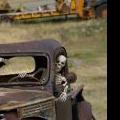Eisenhower had two. Columbine II and III. USAF held on to it until 1968 when it was sold for scrap.
Constellation was a former presidential aircraft. In the years to come, Christler would team up with his son, Lockie, and other family members to restore Columbine II. Harry Oliver joined the effort in 1989, and remains a co-owner today. By 1990, the aircraft had been restored to flying condition, standard Air Force livery removed in favor of the presidential paint scheme. Columbine II was flown to various events commemorating Eisenhower’s 100th birthday in 1990, and joined a few airshows in 1991. Oliver and Lockie Christler have tried for years to find a buyer, or a museum willing to trade for the aircraft, but it stirred little interest until recently. Brett Crowley, Lockie’s nephew and the late Mel’s grandson, said active discussions are under way with the Air Mobility Command Museum in Dover, Del., that may give Columbine II a new home if the particulars can be worked out.
The owners hope to once again restore the aircraft, now stored on an airfield in Tuscon, Ariz., to flying condition, and secure a ferry permit to bring it east “She needs to fly at least one more time,” Brett said.
Tim said making the aircraft airworthy may be a challenge: It basically needs an annual, he said—one that could cost about $200,000. (His brother Brett was a little more optimistic about the extent of required work.)
Columbine III, which replaced Columbine II in 1954 as the primary presidential aircraft, is today in the collection of the National Museum of the U.S. Air Force in Dayton, Ohio. It was the last propeller-driven presidential aircraft, giving way to the Boeing 707 under President John F. Kennedy. The Air Force began using the “Air Force One” call sign in the 1950s to avoid confusion with airlines operating with similar call signs. It is not clear which of the two Columbines were first flown under the now-famous call sign that indicates an aircraft has the president on board. It is well-established, however, that Eisenhower used Columbine II on several occasions, a fact that Mel impressed on his grandson in 1989, when Brett Eisenhower visited the aircraft during a vacation from military school.
The quintet caught the eye of Mel Christler in 1970. Christler operated Christler Flying Service, and was building up a fleet of aerial sprayers to win a government contract to eradicate fire ants. Columbine II had been fitted with landing gear designed for the larger Super Constellation, and was used for spare parts to keep the other four flying.
“It appears that the military let loose of it by mistake,” Christler’s grandson, Tim Crowley, said.
The constellations, according to a recollection written by Christler and provided by the family, were not well-suited to distributing the dry fire ant bait, but came into their own during Canada’s battle against the Spruce Budworm, and in American efforts to control grasshoppers. Eisenhower’s former ride stayed on the ground, slowly being stripped of parts.
In 1980, a call from the Smithsonian National Air & Space Museum alerted Christler that his “spares” Constellation was a former presidential aircraft. In the years to come, Christler would team up with his son, Lockie, and other family members to restore Columbine II. Harry Oliver joined the effort in 1989, and remains a co-owner today. By 1990, the aircraft had been restored to flying condition, standard Air Force livery removed in favor of the presidential paint scheme. Columbine II was flown to various events.
NOW




